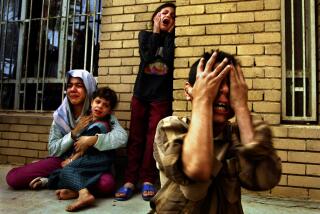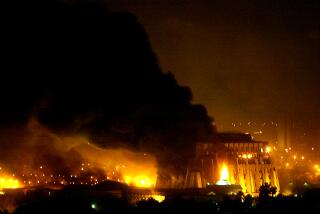Educating for Liberation
- Share via
A millennium or so ago, Baghdad was the world center of learning, the place that gave rise to everything from algebra to many of the swashbuckling and seductive tales in “The Thousand and One Nights.” That history makes the shame of Saddam Hussein’s perversion of the education system all the deeper. Iraqi pride in that history complicates the U.S. Agency for International Development’s project to rebuild and reopen battered classrooms so that 4 million Iraqi children can have a place to sit by Oct. 1.
Two weeks ago, the American Manufacturers Export Group, a Texas-based company, was chosen as a subcontractor to provide student book bags, pencils, papers and other classroom supplies. USAID is now choosing contractors for another fairly straightforward task: repairing thousands of classrooms damaged by bombing, shooting or looting. The next step -- deciding what will be taught -- will obviously be harder.
This month, USAID awarded Creative Associates International, a Washington, D.C., consulting firm, a contract worth up to $63 million to help train Iraqi teachers and principals and develop curriculum reforms. Since its founding in 1977, the company has acquired a respectable track record in helping teach war refugees abroad. Last month, a consortium led by the firm airlifted 50 tons of new primary-school textbooks to schools across Afghanistan.
Reforms in educated Iraq, where at least three-quarters of adults are literate, will prove less straightforward than in Afghanistan, where 98% of the population is illiterate. The best chance of success lies in respecting and involving Iraqi teachers, administrators and academics at every step and freely inviting outside monitoring.
The most difficult task may involve textbooks. In the next few weeks, USAID plans to publish invitations to bid on developing new ones, without the heroic images of Hussein or, as one USAID official put it, “a lot of the hatred and intolerance perpetuated through textbooks for children as young as 7 or 8.”
What needs changing isn’t always simple. For instance, Iraqi intellectuals found subversive ways to criticize Hussein in the authorized textbooks. In one text cited by Eric Davis, director of the Center for Middle Eastern Studies at Rutgers University, criticisms of certain Babylonian kings in the first millennium are disguised attacks on Hussein’s capricious brutality. And descriptions of leftist intellectuals’ scorn for rural Iraqis in the 1980s are cloaked criticisms of the Baath Party. Teachers will be stuck with old textbooks for a while, and it will be important for them to find their own ways to teach around the propaganda.
USAID officials are right to take charge of replenishing supplies, repairing classrooms and even hiring teachers. (If only they would do the same for Los Angeles schools.) Ultimately, however, Iraq’s education reform must be local, stemming from a U.S. intent to liberate rather than conquer.
More to Read
Sign up for Essential California
The most important California stories and recommendations in your inbox every morning.
You may occasionally receive promotional content from the Los Angeles Times.













